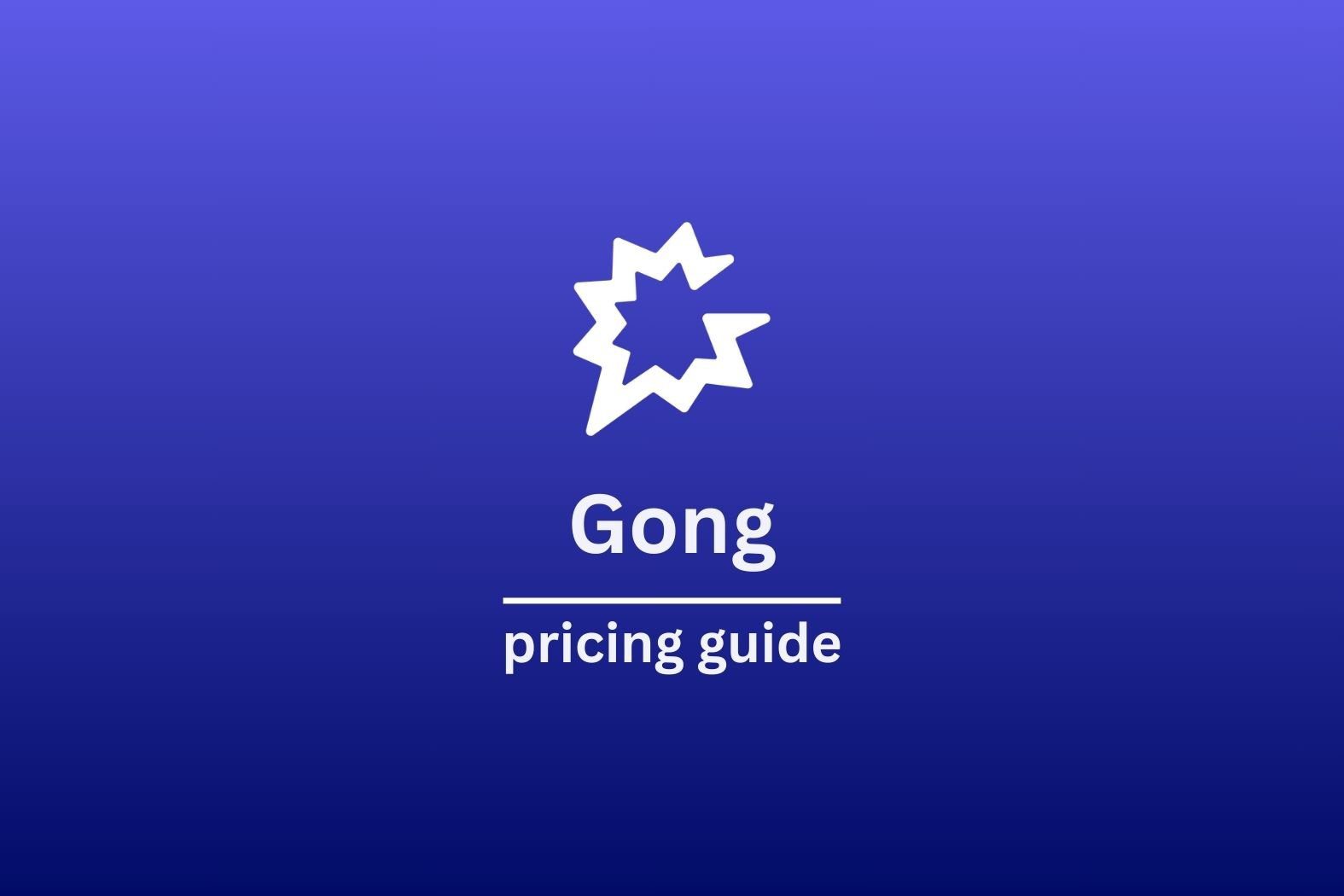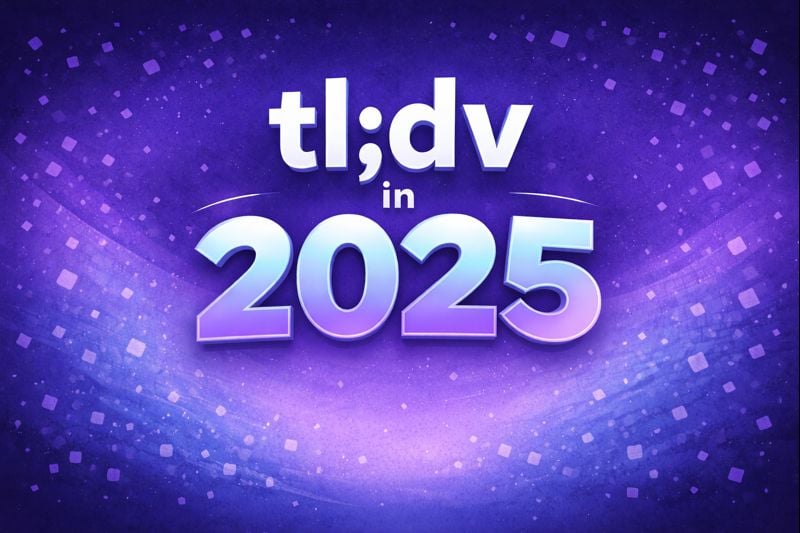C'est désormais une évidence : en 2024, si vous voulez tenir tête à vos concurrents, vous devrez maximiser votre intelligence conversationnelle. Jiminny utilise la technologie de l'IA pour vous aider à analyser vos communications commerciales et à les intégrer à un tableau de bord d'intelligence commerciale.
Mais ce n'est pas pour tout le monde.
Il existe des dizaines d'alternatives à Jiminny qui se disputent toutes le trône de l'assistant de réunion IA. Certaines proposent des fonctionnalités de revenue intelligence, tandis que d'autres se spécialisent dans le coaching commercial et l'intelligence multi-réunions. Ce qui fonctionne le mieux pour votre entreprise dépendra entièrement de vos besoins uniques. Il n'existe pas de solution unique.
Avant de nous pencher sur les alternatives et les concurrents, faisons le point sur Jiminny pour voir ce qu'il en est pour 2024 et au-delà.
Revue de presse de Jiminny : Qu'est-ce que Jiminny ?
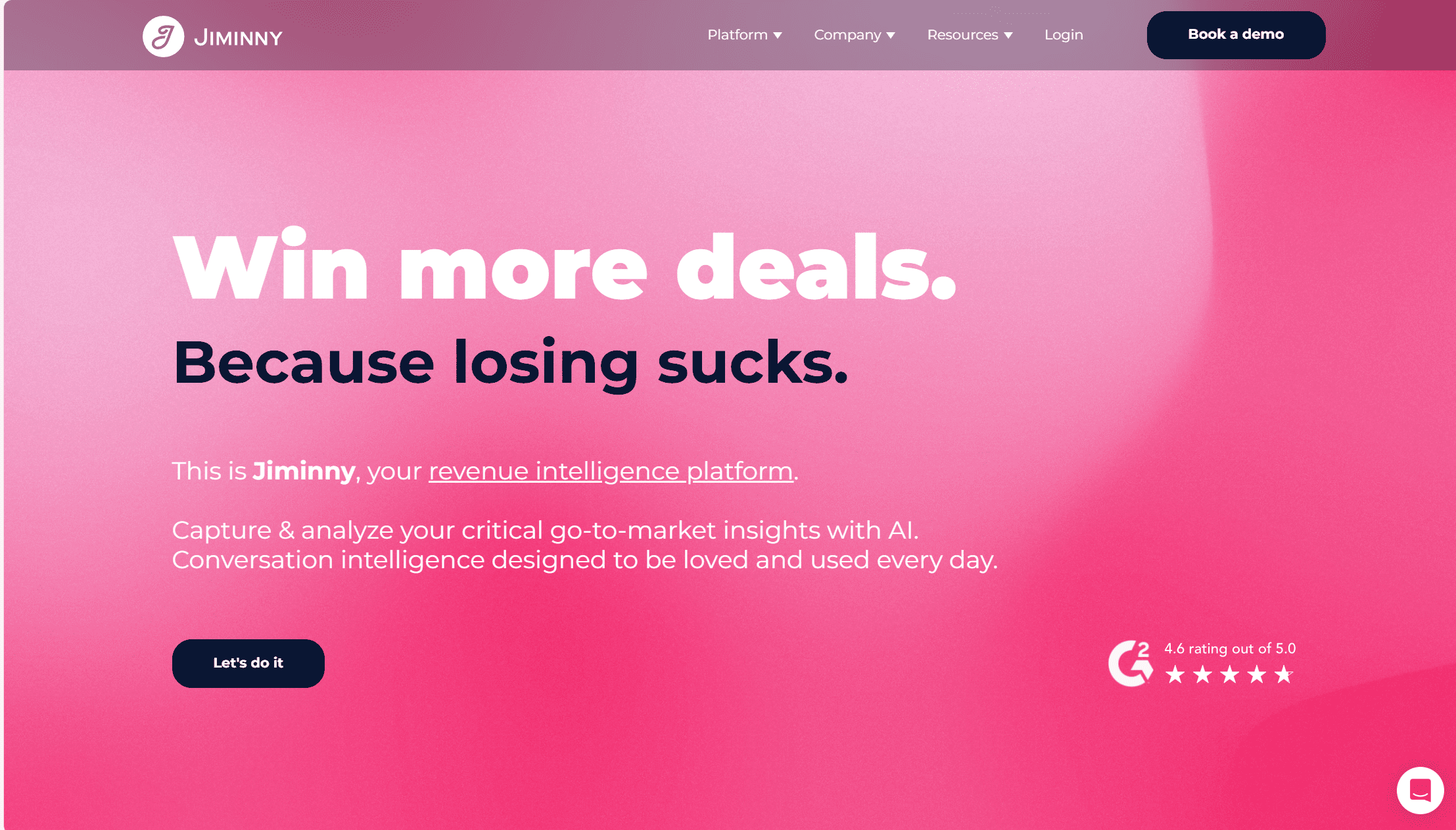
Jiminny est une plateforme de revenue intelligence qui enregistre, transcrit et analyse le contenu des communications vidéo, vocales et électroniques. Conçue pour l'utilisateur, elle est si facile à utiliser qu'elle devient un élément essentiel de l'équipe. Au final, la promesse est que votre équipe conclura davantage de contrats.
Des études montrent que les entreprises qui utilisent l'automatisation du marketing pour nourrir leurs prospects voient leur nombre de leads qualifiés augmenter de 451%. Jiminny a l'intention d'aller plus loin en automatisant également le "meeting intelligence". Toutefois, il convient de noter que le niveau d'automatisation de Jiminny n'est pas encore à la hauteur pour de nombreuses personnes. De nombreux utilisateurs critiquent le fait que la plupart des fonctions d'automatisation de Jiminny nécessitent encore une intervention manuelle. Il n'est pas possible d'envoyer automatiquement toutes les informations relatives aux réunions dans le CRM, il faut encore interagir pour que cela fonctionne.
Jiminny présente néanmoins de nombreux avantages. Il permet d'analyser, de suivre et de contrôler les appels de vente. Cela permet à vos commerciaux de mieux comprendre les interactions avec les clients, d'apprendre au fur et à mesure et de s'assurer qu'aucune opportunité n'est laissée de côté.
Jiminny permet également de suivre les indicateurs de performance commerciale, de mesurer les progrès réalisés par rapport aux objectifs fixés et d'analyser les tendances pour établir des prévisions en toute confiance. La fonction "Deal Insights" vous permet également d'avoir une vue d'ensemble des transactions. Que vous souhaitiez avoir une vue d'ensemble ou plonger dans les détails, Jiminny vous permet de faire les deux. Cela vous permet d'identifier les opportunités de formation commerciale, de prioriser les affaires les plus importantes et d'améliorer les performances de l'équipe de vente grâce à des prévisions précises.
Jiminny dispose également d'un chatbot de type GPT avec lequel vous pouvez discuter pour comprendre les préoccupations et les blocages, l'engagement des clients et les risques liés aux transactions. Il fournit même un retour d'information sur le coaching et s'occupe des notes d'appel et des e-mails de suivi.
Que pensent les directeurs commerciaux de Jiminny ?
97% des responsables commerciaux affirment que l'IA permet aux commerciaux d'avoir plus de temps pour vendre. Certains clients de Jiminny peuvent en témoigner :
- Scoro a amélioré son taux de réussite de 15 % au cours du premier mois.
- Connectd a enregistré une croissance de ses revenus de 11 % d'un mois sur l'autre.
- Lemon.io affirme avoir réduit de 62 % le taux d'attrition des clients.
Dans l'ensemble, les utilisateurs de Jiminny sont satisfaits. Il obtient un bon score de 4,6/5 sur G2 à partir de 540 avis. La plupart des avis positifs soulignent la facilité d'utilisation, l'enregistrement des appels et l'utilité de l'outil pour condenser les réunions en des résumés faciles à numériser. Les critiques portent généralement sur les problèmes liés aux appels, la faible précision de la transcription ou le manque d'automatisation.
Voyons plus en détail les avantages et les inconvénients de Jiminny.
Jiminny Pros
- Tableau de bord des revenus. Jiminny Deal Insights vous permet de faire des prévisions précises et de gérer efficacement votre pipeline.
- Coaching commercial. Jiminny propose plusieurs outils pour aider les directeurs commerciaux à coacher leurs représentants, notamment des conseils sur le traitement des objections et le site playbooks (pour les ventes et la réussite des clients).
- Interface utilisateur conviviale. En général, l'interface utilisateur est claire et facile à utiliser.
- Compatibilité. Jiminny fonctionne avec les appels vidéo, les appels vocaux et les e-mails, ce qui vous permet de ne manquer aucun détail.
- Evaluation automatisée des appels. Suivi automatique de chaque interaction avec le client.
- Demandez à Jiminny. Jiminny dispose d'un chatbot intégré de type GPT qui permet de passer en revue les problèmes et les obstacles.
Jiminny Cons
- Intégrations. Jiminny dispose de moins de 40 intégrations, ce qui en fait un outil risqué pour rationaliser les flux de travail au sein d'un ensemble d'outils préexistants.
- Automatisation. La plupart des intégrations proposées par Jiminny nécessitent encore une action manuelle pour partager les données. Cela peut sembler une étape inutile par rapport à certaines alternatives de Jiminny qui le font automatiquement.
- Qualité des appels. Certains utilisateurs signalent que l'audio ou la vidéo est parfois perturbée.
Tarification Jiminny
Jiminny précise explicitement que ce n'est pas pour vous si vous.. :
- N'ont pas de CRM ;
- Ne pas avoir d'équipe de vente.
Cependant, il ne propose pas de prix ni de paliers d'abonnement. Au lieu de cela, il vous demande de réserver une démonstration et de parler à un représentant commercial.
La tarification exacte variera d'un client à l'autre en fonction de leurs besoins, mais on pense que le coût minimum par utilisateur sera d'environ 85 dollars par mois.
Top 4 des alternatives à Jiminny
1. tl;dv
tl;dv est une alternative fantastique à Jiminny si vous souhaitez en avoir plus pour votre argent. Bien qu'elle n'offre pas les fonctionnalités de revenue intelligence de Jiminny, elle propose du coaching commercial, des playbooks, des scorecards et de bien meilleures intégrations et automatisations.
Pour montrer que nous n'exagérons pas, vous pouvez comparer le nombre d'intégrations entre tl;dv et Jiminny. Jiminny en a un peu plus de 40. tl tl;dv en a bien plus de 5 000! En d'autres termes, pour chaque intégration de Jiminny, tl;dv en a environ 120. Vous aurez beaucoup plus de chances que tl;dv s'intègre à votre boîte à outils actuelle que Jiminny.
De plus, l'automatisation de tl;dvfonctionne réellement. Si vous souhaitez remplir votre CRM avec des notes de réunion, des transcriptions ou des résumés, vous pouvez le faire. C'est automatique, vous n'avez donc pas besoin de lever le petit doigt.
tl;dv dispose également d'autres fonctions automatisées qui vous permettent de gagner du temps et de l'énergie. Par exemple, avec tl;dv , vous pouvez programmer des rapports récurrents pour obtenir des résumés AI de plusieurs réunions à la fois. Si vous êtes directeur commercial, tl;dv vous permet d'obtenir des rapports hebdomadaires (ou à la fréquence de votre choix) contenant des informations tirées de tous les appels passés par vos commerciaux au cours de la semaine. Vous pouvez indiquer à l'IA les sujets sur lesquels vous souhaitez obtenir des rapports et vous pouvez choisir parmi toute une série de filtres pour prédéfinir vos rapports. Vous n'avez plus besoin de résumer chaque réunion individuellement, il vous suffit de le faire en masse.
Cette fonction est parfaite pour les responsables des ventes, mais elle peut également être utilisée par les responsables de la réussite des clients, les chefs de produit ou même les chercheurs d'utilisateurs qui souhaitent recueillir des informations à partir de tous leurs entretiens avec les utilisateurs en une seule fois. Les possibilités sont infinies.
En ce qui concerne le coaching commercial, le tableau de bord analytique de tl;dvcouvre tout, du temps de parole de vos commerciaux aux questions posées, en passant par les mots de remplissage utilisés, et bien plus encore. Vous pouvez utiliser des playbooks prédéfinis tels que BANT et MEDDIC ou créer votre propre playbooks .
En ce qui concerne les langues, tl;dv excelle également. Il dispose d'une plateforme localisée en 7 langues différentes, ce qui en fait un excellent choix pour les équipes multinationales. Il traduit également les transcriptions (gratuitement) dans plus de 40 langues. Jiminny traduit des transcriptions dans un nombre similaire de langues (payant uniquement), mais ne propose pas de plateforme localisée pour les autres nationalités.
L'un des points forts de tl;dv , et l'une des principales raisons pour lesquelles il occupe la première place de cette liste d'alternatives à Jiminny, est son offre gratuite. Alors que Jiminny ne propose pas d'offre gratuite et enferme ses offres payantes derrière un argumentaire de vente, tl;dv propose des enregistrements, des transcriptions, des traductions et des résumés AI gratuits et illimités. La tarification est transparente et vous pouvez vous installer et enregistrer votre première réunion en quelques minutes.
Avantages de tl;dv
- Intégration gratuite de l'IA: tl;dv capitalise sur l'IA haut de gamme pour fournir des résumés, des notes et une détection automatique des orateurs.
- Traductions gratuites et instantanées: les transcriptions de tl;dvsont disponibles dans plus de 40 langues pour Zoom, MS Teams et Google Meet
- Une formule gratuite incroyable, qui comprend des transcriptions et des enregistrements gratuits et illimités pour Zoom, MS Teams et Google Meet.
- Facile à utiliser: la conception élégante de tl;dvrend son utilisation très facile pour les débutants comme pour les experts.
- Intelligence multi-réunions. Demandez à recevoir des rapports à intervalles réguliers dans votre boîte mail pour condenser plusieurs résumés de réunions sans lever le petit doigt.
- Coaching commercial. Améliorez votre équipe de vente en utilisant les informations tirées de vos appels de vente. Améliorez le traitement des objections et utilisez des modèles ou playbooks pour personnaliser votre stratégie de coaching.
- Fonctionnalités d'horodatage et d'étiquetage : Horodatez les moments clés de vos réunions pour y revenir en un clin d'œil, et ajoutez des étiquettes pour mentionner des moments de réunions à vos collègues sous forme de lien dans leur boîte mail.
- Plus de 5 000 intégrations: Transférez des horodatages et des clips de réunion directement vers Notion, Slack, HubSpot, Salesforce, et plus de 5 000 autres applications grâce à des intégrations natives.
- Créez des clips et synthétisez des moments clés : Scannez votre bibliothèque et créez des clips et des reels pour condenser les points les plus importants.
- Bibliothèque intuitive : Recherchez des mots-clés dans votre bibliothèque de réunions et de transcriptions pour trouver rapidement ce que vous cherchez.
- Réunions simultanées. Vous pouvez enregistrer, transcrire et résumer plusieurs réunions simultanément. C'est idéal si vous êtes doublement (ou triplement) occupé.
Inconvénients de tl;dv
- Compatibilité : tl;dv n'est pas encore disponible pour Webex ou BlueJeans.
- Pas de Revenue Intelligence. L'IA de tl;dvne peut pas être utilisée pour prévoir les transactions.
Tarifs
Aucun des concurrents de Jiminny de cette liste ne peut rivaliser avec tl;dv en termes de plan gratuit et de structure tarifaire en général.
Il vous permet d'essayer toutes les fonctionnalités de base sans pression ni contrainte de temps. De plus, selon la région du monde où vous vous trouvez, vous pouvez bénéficier d'une réduction allant jusqu'à 40 % sur les plans payants !
Options de la formule gratuite
- Enregistrements vidéo et transcriptions illimités
- Enregistrez des appels sur Google Meet, Zoom, et MS Teams
- Transcriptions dans plus de 40 langues
- Résumés IA illimités de moments de réunions
- 10x plus de notes de réunion IA
- Questions x10 à l'IA de tl;dv
- 10x plus de rapports multi-réunions générés par l'IA
- Intégrations Slack et applis d'e-mail et calendrier
- Créez des horodatages et moments clés
- Créez et partagez des clips
- Reconnaissance automatique des intervenants
- 3 téléversements mensuels
Les plans payants de tl;dvdébloquent plus de 5 000 intégrations, des playbooks coaching commercial, une intelligence illimitée pour les réunions multiples, des rapports récurrents, des analyses, des enregistrements téléchargeables, des paramètres de partage personnalisables, un support client prioritaire, et bien plus encore...
Découvrez tout cela en détail ici.
tl;dv vs Jiminny
Jiminny devrait être votre premier choix si vous ne recherchez rien de moins que l'intelligence des revenus. Mais si vous recherchez un assistant de réunion IA pour les équipes de vente, les équipes de réussite client, les produits ou même la recherche utilisateur, alors tl;dv est le grand gagnant.
Non seulement tl;dv est plus abordable (et dispose d'un plan premium gratuit), mais il est également conçu dans une optique d'automatisation. Il propose des tonnes d'intégrations, une plateforme localisée en 7 langues, une intelligence multi-réunions, des rapports récurrents et l'enregistrement simultané des réunions.
Là où Jiminny obtient un score de 4,6, tl;dv obtient un score encore meilleur de 4,7/5. C'est une bonne indication en termes de rapport qualité-prix.
2. Gong
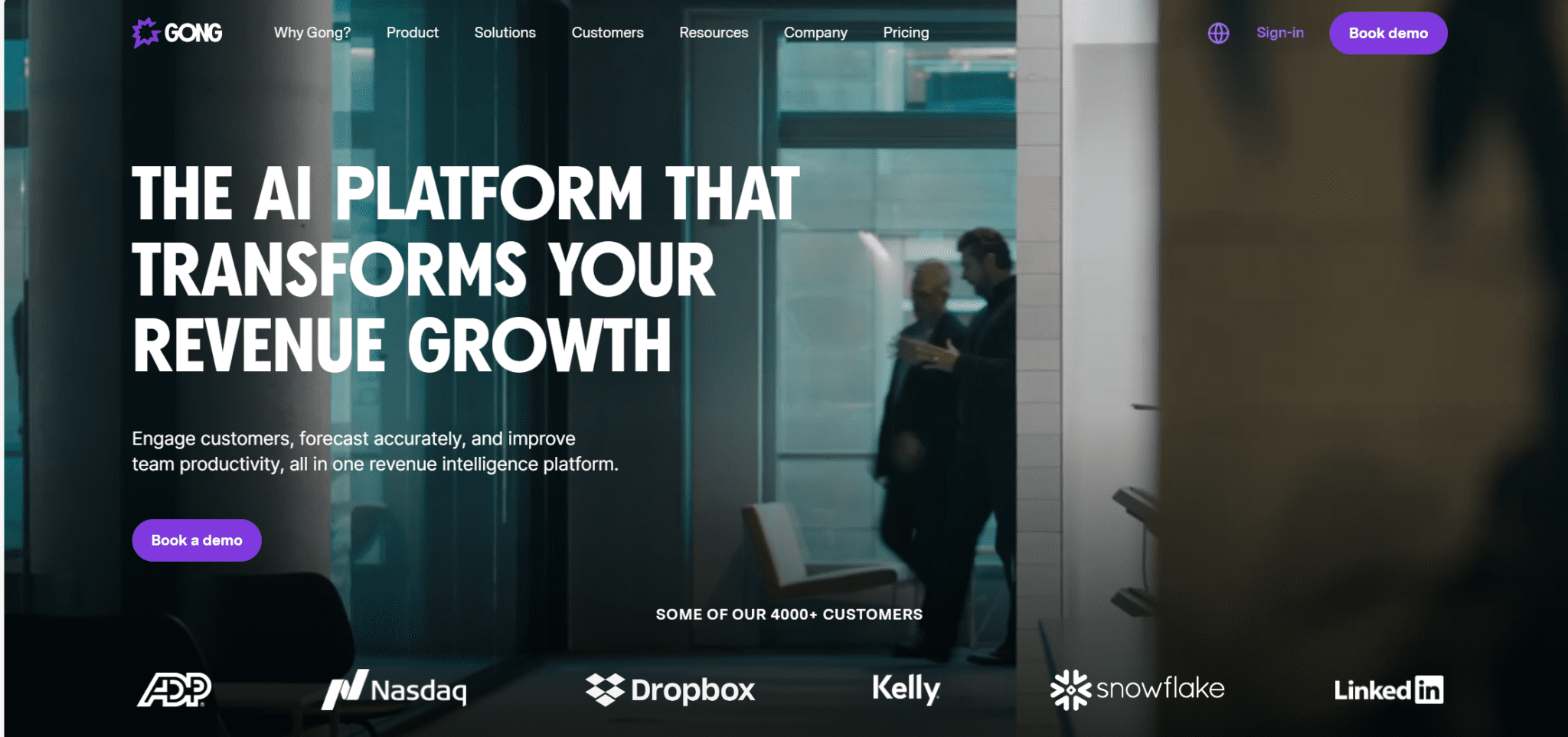
Gong est l'une des meilleures alternatives à Jiminny en matière de revenue intelligence. Il s'agit sans doute de la plateforme de revenue intelligence la plus populaire et elle bénéficie de certaines des meilleures critiques du secteur. Cependant, il y a une mise en garde immédiate : si vous n'avez pas l'intention de maximiser les ventes et les informations sur les revenus de Gong, il ne vaut certainement pas la peine de payer le prix élevé qu'il coûte. En revanche, si vous êtes sérieux, Gong pourrait très bien vous convenir.
Gong peut être un peu complexe pour les nouveaux venus. Cependant, il y a un avantage potentiel à cela. Bien qu'il faille beaucoup de formation pour apprendre à votre équipe à utiliser efficacement Gong , il est juste de dire qu'en l'utilisant, vous pourrez réduire le nombre de vos autres outils, car il prend en charge un grand nombre d'aspects différents de la vente. Après tout, 25 % des responsables des ventes estiment qu'ils ont trop d'outils dans leur pile technologique. Gong peut vous aider à réduire ce nombre.
Mais il y a un problème. Outre la formation de votre équipe à un outil complexe tel que Gong, qui prendra du temps et de l'argent, il y a un coût encore plus important à prendre en compte : l'abonnement lui-même.
Comme nous l'avons expliqué dans notre comparaison tl;dv vs Gong, la tarification de Gongest si extraordinairement élevée que vous pourriez avoir à payer plus de 75 000 $ avant qu'une seule vente ne soit réalisée (pour une équipe de 49 personnes). C'est un engagement énorme.
Avantages de Gong
- Intégrations. Gong dispose de centaines d'intégrations qui permettent de connecter vos espaces de travail en toute transparence.
- Revenue Intelligence. GongRevenue Intelligence vous permet de prévoir les ventes et de faciliter l'exécution des contrats.
- Coaching de vente. Gong offre des playbooks personnalisés, des cartes de score, des modèles et des formations sur le traitement des objections.
- Analyse des sentiments. L'IA de Going analyse les émotions des clients pour vous aider à conclure des ventes.
Gong Cons
- Coût élevé. Non seulement il faut passer par un appel de vente pour obtenir les tarifs de Gong, mais ces tarifs sont en plus notoirement élevés, car la plateforme est conçue pour les grandes entreprises.
- Fortement axé sur les ventes. Gong est tellement axé sur les équipes de vente qu'il n'est pas vraiment utile de l'utiliser si vous n'avez pas l'intention de maximiser ses fonctions de vente.
- Onboarding long et fastidieux. Pour accéder à Gong, vous devez franchir quelques étapes, ce qui peut être frustrant et prendre du temps.
- Recommandations intrusives. Certains critiques suggèrent que les recommandations de Gongsur la façon d'améliorer votre argumentaire de vente peuvent être ennuyeuses et non désirées.
Tarifs
Il est aussi difficile de connaître les tarifs exacts de Gongque ceux de Jiminny. Les deux plates-formes cachent leur tarification derrière un appel à la vente.
Comme pour Jiminny, il est possible de se référer à des sources externes pour connaître le coût de l'application, et les chiffres sont assez élevés. Il peut s'élever jusqu'à 1600 dollars par utilisateur et par an, mais le seul moyen de connaître le prix exact pour les besoins spécifiques de votre entreprise est de les appeler et de discuter avec eux.
Jiminny vs Gong
Jiminny et Gong sont tous deux des plateformes de revenue intelligence de premier ordre. Gong est certainement la plus complète des deux. Elle obtient la note impressionnante de 4,7/5 sur G2 grâce à près de 6 000 avis d'utilisateurs. Cela devrait vous dire tout ce que vous avez besoin de savoir sur la qualité et le rapport qualité-prix de Gong.
Gong excelle également en ce qui concerne la quantité (et la capacité d'automatisation) de ses intégrations. Les deux plateformes souffrent cependant d'un onboarding fastidieux.
3. Avoma
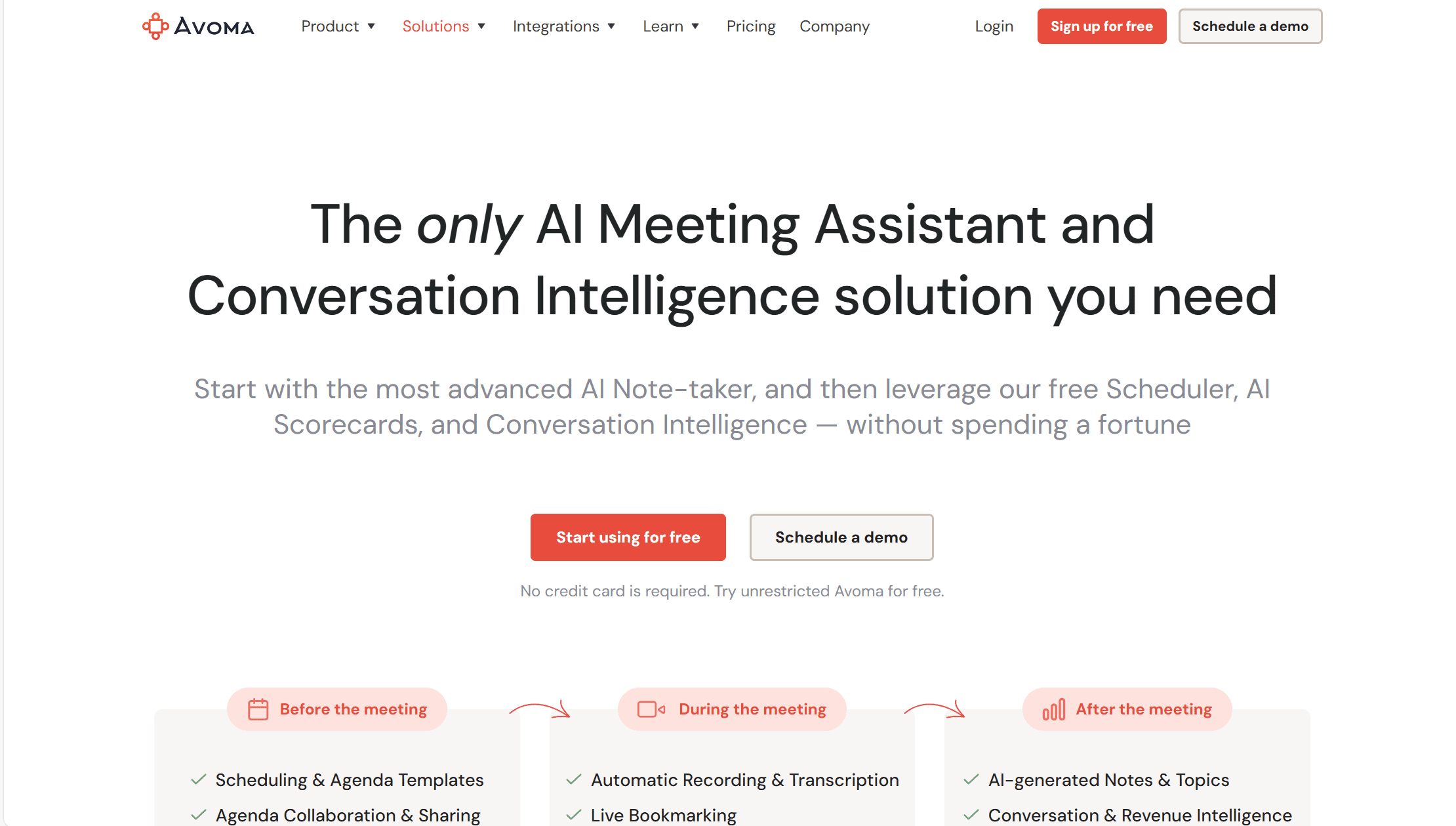
Avoma est une solution intéressante à mi-chemin entre les deux alternatives précédentes à Jiminny : tl;dv et Gong. Alors qu'il s'agissait à l'origine d'un assistant de réunion IA, il a évolué vers une solution d'intelligence conversationnelle avec des fonctionnalités d'intelligence des revenus. Elle est plus chère que tl;dv et les plans les plus abordables offrent beaucoup moins de valeur, mais ses fonctions de revenue intelligence ne font pas le poids face à celles de Gong.
Jiminny et Gong sont des plateformes de vente et de revenus avec des fonctions d'assistant de réunion IA, tandis qu'Avoma et tl;dv sont des assistants de réunion IA avec des fonctions de vente et de revenus. La question de savoir si Avoma est une bonne alternative à Jiminny dépend de ce que vous attendez exactement de cet outil.
Il vous aide à gérer l'ensemble du cycle de vie du client, à préparer les réunions à venir et à prendre des notes en toute simplicité. Après l'appel, l'IA de Avomaexamine la transcription et fournit des informations intéressantes qui peuvent conduire à d'importantes décisions en matière de ventes ou de revenus.
L'un des grands avantages de Avoma est qu'il est disponible pour de nombreuses plateformes de vidéoconférence. Il fonctionne avec les trois principales : MS Teams, et : MS Teams, Zoom et Google Meet. Cependant, Avoma est également compatible avec UberConference, BlueJeans, GoToMeeting, etc. C'est une bonne chose pour les équipes qui utilisent une plateforme de vidéoconférence plus obscure pour leurs réunions et qui préfèrent ne pas modifier l'ensemble de leur système.
Malheureusement, les autres intégrations de Avoman'ont pas le même sentiment. En fait, elles ne sont pas bonnes du tout. Il ne s'intègre même pas à Zapier, de sorte que vous ne pouvez pas non plus utiliser un tiers pour connecter vos outils de travail. Cela pourrait être son talon d'Achille pour les équipes de ventes et de revenus qui ont besoin d'extraire des données d'une multitude d'endroits différents. AvomaL'absence d'intégrations signifie que vous devrez transférer manuellement les données entre vos outils - ce que vous utilisez probablement l'IA pour éviter !
L'autre inconvénient concerne la prise en charge des langues. Bien qu'il puisse traduire des transcriptions dans plus de 30 langues, il ne dispose pas d'une plateforme localisée dans une autre langue que l'anglais. Cela en fait une perte de temps pour les équipes non anglophones.
Avantages d'Avoma
- Compatibilité. Il peut être utilisé sur Google Meet, Zoom, Microsoft Teams, BlueJeans, UberConference, GoToMeeting, et plus encore...
- Coachingcommercial. Il propose un coaching commercial basé sur des informations personnalisées.
- Revenue Intelligence. Planifiez mieux votre pipeline de vente en prévoyant les contrats grâce à l'IA de Avoma.
- Collaboration. Un outil de collaboration qui permet à plusieurs personnes de modifier des notes en temps réel.
- Facilité de recherche. Base de données consultable pour toutes les réunions.
- Plan gratuit. Plan gratuit standard.
Inconvénients d'Avoma
- Intégrations. Il n'y a pas d'intégration Zapier, pas d'intégration d'email, et les intégrations CRM vous coûteront 49$/mois.
- Soutien linguistique. Il n'existe pas de plateforme localisée pour les utilisateurs non anglophones.
- Assistance à la clientèle. Il n'y a pas de support client pour le plan gratuit, et seulement un support limité pour les plans Business et Enterprise.
Tarifs
Le plan de démarrage d'Avoman'offre que 2 400 minutes de transcription par mois, mais il vous coûtera 19 $ par utilisateur et par mois. À titre de comparaison, tl;dv offre gratuitement un nombre illimité de transcriptions.
La formule Plus passe à 49 $ par mois et débloque les intégrations CRM (que tl;dv propose en plus pour 19 $ par mois) et les transcriptions illimitées.
AvomaLe plan d'affaires d'EMC coûte 79 $ par mois et fournit des tableaux de bord de l'IA ainsi que des renseignements avancés sur les conversations et les revenus.
AvomaLe prix du plan d'entreprise est de 129 $ par utilisateur et par mois, ce qui le place dans la même catégorie que Gong et Jiminny.
Options de la formule gratuite
- Enregistrement et transcription (300 minutes par mois)
- Notes IA limitées
- Prise de notes collaborative
- Préparation des ordres du jour
- Planificateur de One on One illimités
Avoma offre une période d'essai gratuite de 14 jours pour tous ses plans, ce qui vous permet de tester ses fonctions avancées sur une période de deux semaines. C'est une bonne chose pour les anciens utilisateurs de Jiminny qui veulent essayer Avoma comme remplaçant potentiel.
Avoma vs Jiminny
Jiminny est probablement un meilleur choix pour les équipes chargées du chiffre d'affaires qui ont besoin d'une intelligence du chiffre d'affaires à la pointe de la technologie. Alors que le tableau de bord des revenus de Avomaoffre une excellente vue d'ensemble du pipeline et aide les utilisateurs à mieux gérer leurs flux de travail et à prévoir les contrats grâce à l'intelligence conversationnelle, Jiminny fait tout cela aussi et depuis plus longtemps.
Avomaest cependant le meilleur enregistreur de réunions. Si vous préférez l'aspect "intelligence de réunion" de ces outils et que vous n'êtes pas trop préoccupé par le fait que l'intelligence de revenu soit à la pointe de l'industrie, alors Avoma est un choix solide (mais coûteux).
4. Modjo
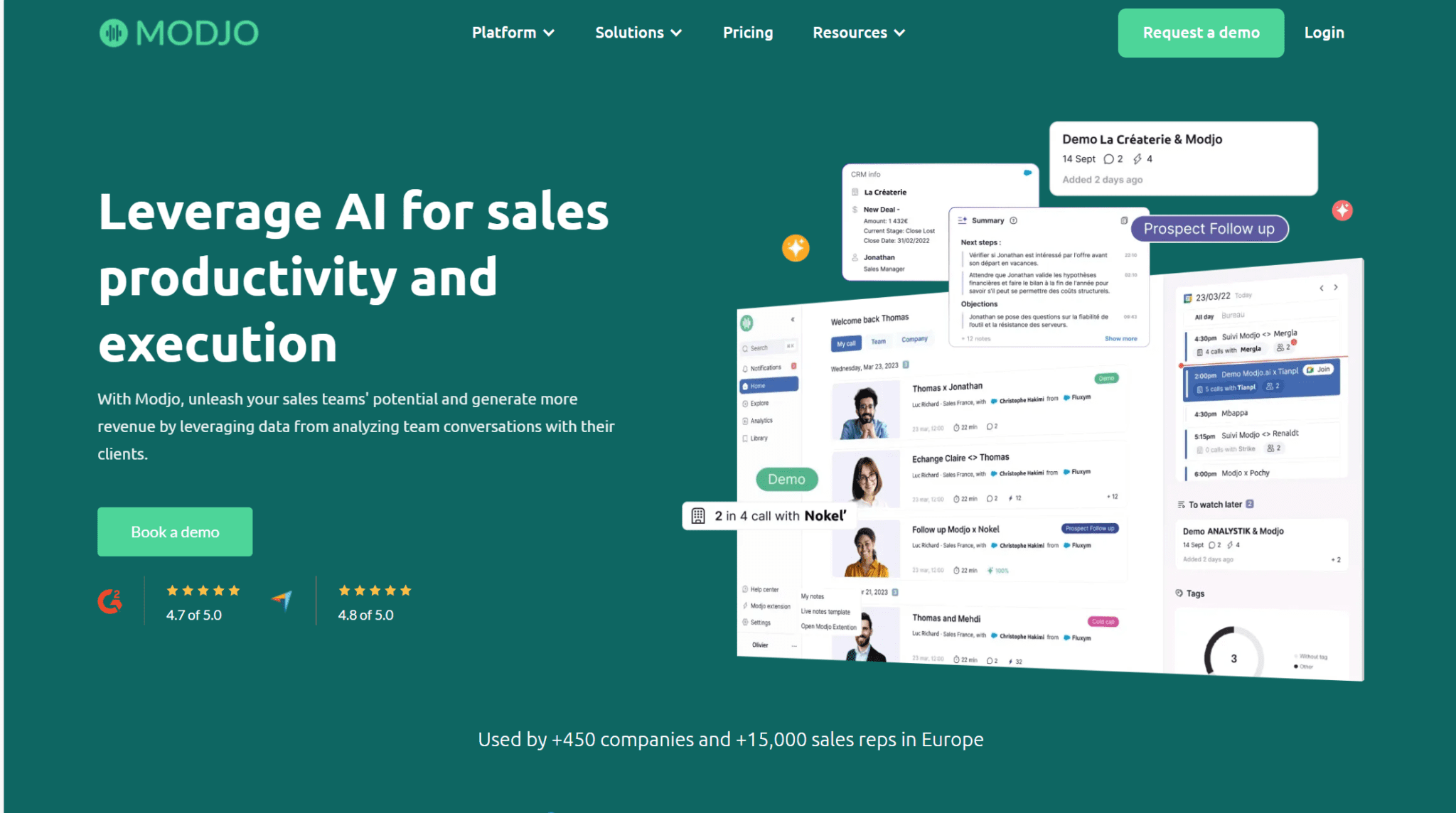
Modjo est une fantastique plateforme de revenue intelligence qui s'appuie sur l'IA pour aider votre équipe de vente à conclure plus de contrats. Elle prétend faire gagner aux commerciaux plus de 4 heures par semaine. Les utilisateurs de Modjoaugmentent leur taux de conversion de plus de 20 % en moyenne.
Comme la plupart des alternatives à Jiminny, son objectif est d'améliorer le chiffre d'affaires de votre entreprise en analysant les appels de vente et en mettant à profit les informations recueillies pour créer des stratégies de vente nouvelles et améliorées. Modjo traite les données de tous vos appels de vente afin d'optimiser votre stratégie de vente, ce qui permet aux responsables commerciaux et aux représentants de gagner du temps et de l'énergie.
Modjo Pour
- Simple Notes. ModjoL'IA de Simple Notes s'occupe des notes de réunion pour que vous puissiez vous concentrer sur la conversation. Il les synchronise automatiquement avec vos CRM, mais aussi avec tous les outils de travail en un seul endroit centralisé et facilement accessible.
- Améliore la productivité. En automatisant les tâches de routine, Modjo permet à vos commerciaux d'économiser des heures chaque semaine.
- Modjo Résumés d'appels. ModjoLes résumés des appels sont des aperçus clairs de tout ce qui s'est passé au cours de la réunion.
- Modjo Contrats. Cette fonction permet aux gestionnaires de revenus de faire des prévisions en toute confiance et de hiérarchiser leur pipeline en conséquence.
Modjo Cons
- Confidentialité. Certains utilisateurs ont critiqué Modjo pour ne pas avoir obtenu l'autorisation des participants à la réunion avant l'enregistrement.
- Courbe d'apprentissage. Comme toutes les plateformes de revenue intelligence, elle peut être un peu écrasante au début.
- Pas de prise en charge des dialectes régionaux. Les transcriptions ne sont pas adaptées aux dialectes régionaux.
- Pas de plan gratuit ou d'essai. Il n'y a aucun moyen d'essayer Modjo sans s'engager à payer plus de 100 $ par mois.
- Intégrations limitées. Modjo offre moins de 40 intégrations.
Tarifs
Comme pour Gong et Jiminny, les tarifs de Modjone sont pas faciles à trouver. Vous devrez passer un entretien de vente au cours duquel vous établirez un plan personnalisé en fonction des besoins de votre entreprise.
Il n'y a pas de plan ou d'essai gratuit. On s'attend toutefois à ce que l'abonnement à Modjocommence à environ 1 000 dollars par utilisateur et par an.
C'est un prix assez élevé pour les petites entreprises, et le fait qu'il ne soit pas possible d'essayer avant d'acheter ne facilite pas les choses.
Modjo vs Jiminny
Modjo et Jiminny sont des outils très similaires. Ils souffrent tous deux d'un manque d'intégration, mais les intégrations de Modjoautomatisent les flux de travail et facilitent le transfert de grandes quantités de données. Jiminny a du mal sur ce point, car il ajoute des étapes inutiles pour transférer les informations vers votre CRM et d'autres outils.
Modjo Deals est très similaire à l'offre de Jiminny et les deux proposent une interface utilisateur claire. La prévision des ventes est une fonctionnalité intéressante pour les deux outils, de même que le coaching commercial et l'intelligence globale des réunions.
Comme il s'agit de deux plateformes complexes, elles peuvent nécessiter une formation de l'équipe pour tirer le meilleur parti de leurs fonctionnalités. Si votre équipe apprend à connaître les plateformes, le jeu en vaut la chandelle.
L'absence d'essai ou de plan gratuit fait qu'il est difficile de recommander l'achat de Modjo sur un coup de tête, mais si vous êtes intéressé par ce qu'ils ont à offrir, cela vaut la peine de prendre un appel de vente et de parler avec un représentant qui pourra vous donner plus de détails, une démonstration en direct, et peut-être même négocier un essai gratuit sur place. On ne sait jamais sans avoir essayé.
Jiminny Alternatives : Le verdict
Comme toujours, la question se résume à ceci : ce sont les besoins de votre entreprise qui dicteront entièrement le choix de l'outil qui vous convient le mieux.
Si l'intelligence économique est vitale, vous pouvez exclure d'emblée tl;dv . Avoma aurait également du mal à rivaliser avec Gong et Modjo dans le domaine de l'intelligence économique, bien qu'il s'agisse d'un bon choix pour les personnes disposant d'un budget limité et souhaitant disposer d'une certaine forme de fonctionnalité de base sans se ruiner.
Cependant, si vous souhaitez un assistant de réunion AI de premier ordre et que l'intelligence des revenus n'est qu'un facteur secondaire, alors tl;dv s'impose comme le vainqueur incontesté. Son rapport qualité-prix est inégalé et ses fonctions de coaching commercial, son intelligence multi-réunions et ses plus de 5 000 intégrations avec une automatisation complète sont une bouffée d'air frais.


